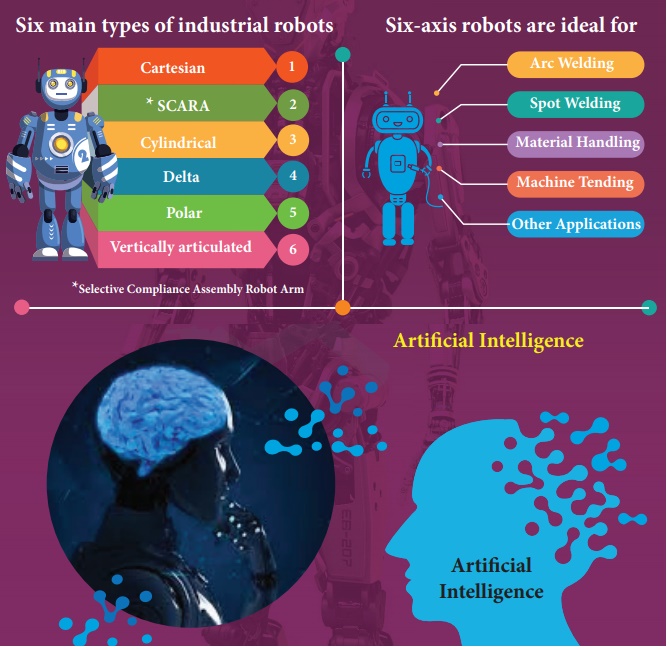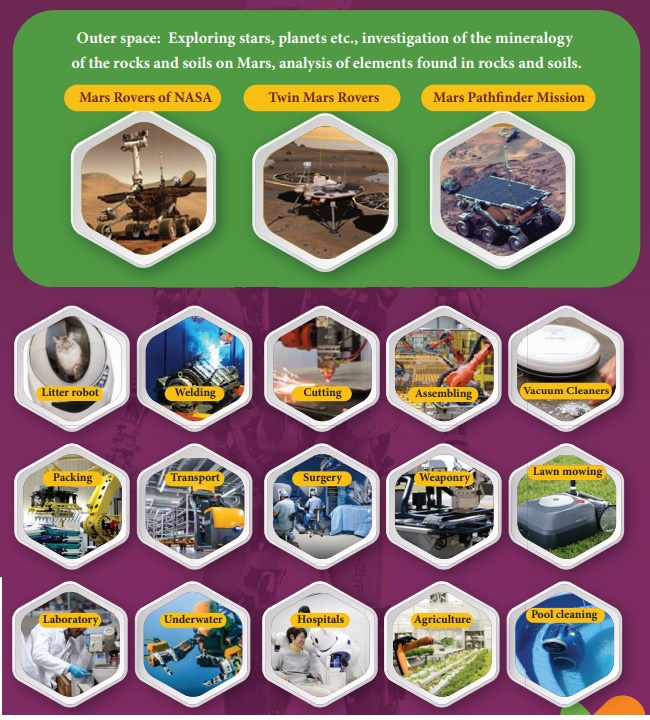Components, Types, Applications, Advantages, Disadvantages - Robotics | 12th Physics : UNIT 11 : Recent Developments in Physics
Chapter: 12th Physics : UNIT 11 : Recent Developments in Physics
Robotics
Robotics
What is robotics?
Robotics is an integrated study of mechanical engineering, electronic engineering, computer engineering, and science. Robot is a mechanical device designed with electronic circuitry and programmed to perform a specific task. These automated machines are highly significant in this robotic era. They can take up the role of humans in certain dangerous environments that are hazardous to people like defusing bombs, finding survivors in unstable ruins, and exploring mines and shipwrecks.

Co-defender, Co-inhabitant, Co-explorer, Co-worker
Logistics, Intelligent transportation, Unmanned vehicles, Rehabilitate orthotics prosthetics, Human- Robot Interfaces, Medical Surgery, Manufacture & Automation Macro, Manufacture & Automation Micro/Nano, Monitoring Inspection, Security, Intelligent Co-Robot, Services
In 1954, George Devol invented the first digitally
operated programmable robot called Unimate. George Devol and Joseph Engelberger,
the father of the modern robotics industry formed the world’s first robot
company in 1956. In 1961, Unimate, was operated in a General Motors automobile
factory for moving car parts around in New Jersey.
COMPONENTS OF ROBOTICS
The robotic system mainly consists of sensors,
power supplies, control systems, manipula- tors and necessary software.

Most
robots are composed of 3 main parts:
1. The
Controller - also known as the "brain" which is run
by a computer program. It gives commands for the moving parts to perform the
job.
2. Mechanical
parts - motors, pistons, grippers, wheels, and gears that make the
robot move, grab, turn, and lift.
3. Sensors
-
to tell the robot about its surroundings. It helps to determine the sizes and
shapes of the objects around, distance between the objects, and directions as
well.
TYPES OF ROBOTS
HUMAN
ROBOT
Certain robots are made to resemble humans in
appearance and replicate the human activities like walking, lifting, and
sensing, etc.
1. Power conversion unit: Robots are powered by
batteries, solar power, and hydraulics.
2. Actuators: Converts energy into movement. The
majority of the actuators produce rotational or linear motion.
3. Electric motors: They are used to actuate the
parts of the robots like wheels, arms, fingers, legs, sensors, camera, weapon
systems etc. Different types of electric motors are used. The most often used
ones are AC motor, Brushed DC motor, Brushless DC motor, Geared DC motor, etc.
4. Pneumatic Air Muscles: They are devices that
can contract and expand when air is pumped inside. It can replicate the
function of a human muscle. They contract almost 40% when the air is sucked
inside them.
5. Muscle wires: They are thin strands of wire
made of shape memory alloys. They can contract by 5% when electric current is
passed through them.
6. Piezo Motors and Ultrasonic Motors: Basically,
we use it for industrial robots.
7. Sensors: Generally used in task environments as
it provides information of real-time knowledge.
8. Robot locomotion: Provides the types of
movements to a robot. The different types are
(a) Legged (b) Wheeled (c) Combination of Legged
and Wheeled Locomotion
(d) Tracked slip/skid
INDUSTRIAL ROBOTS

Six main
types of industrial robots
1. Cartesian
2. * SCARA
3. Cylindrical
4. Delta
5. Polar
6. Vertically articulated
Six-axis
robots are ideal for
1. Arc Welding
2. Spot Welding
3. Material Handling
4. Machine Tending
5. Other Applications
*Selective Compliance Assembly
Robot Arm
Artificial
Intelligence
The aim of artificial intelligence is to bring in
human like behaviour in robots. It works on
1. Face recognition
2. Providing response to player’s actions in
computer games
3. Taking decisions based on previous actions
4. To regulate the traffic by analyzing the
density of traffic on roads.
5. Translate words from one language to another
Applications
Outer space: Exploring stars, planets etc.,
investigation of the mineralogy of the rocks and soils on Mars, analysis of
elements found in rocks and soils.
Mars Rovers of NASA, Twin Mars Rovers, Mars
Pathfinder Mission

Litter robot
Welding
Cutting
Assembling
Vacuum Cleaners
Packing
Transport
Surgery
Weaponry
Lawn mowing
Laboratory
Underwater
Hospitals
Agriculture
Pool cleaning
Nanorobots
The size of the nano robots is reduced to
microscopic level to perform a task in very small spaces. However, it is only
in the developmental stage. The future prospects of it are much expected in the
medical field: Nano-robots in blood stream to perform small surgical
procedures, to fight against bacteria, repairing individual cell in the body.
It can travel into the body and once after the job is performed it can find its
way out. Chinese scientists have created the world’s first autonomous DNA
robots to combat cancer tumours.
Materials used to make robots
For robots, aluminum and steel are the most common
metals. Aluminum is a softer metal and is therefore easier to work with, but
steel is several times stronger. In any case, because of the inherent strength
of metal, robot bodies are made using sheet, bar, rod, channel, and other
shapes.
Advantages of Robotics
1. The robots are much cheaper than humans.
2. Robots never get tired like humans. It can work
for 24 x 7. Hence absenteeism in work place can be reduced.
3. Robots are more precise and error free in
performing the task.
4. Stronger and faster than humans.
5. Robots can work in extreme environmental
conditions: extreme hot or cold, space or underwater. In dangerous situations
like bomb detection and bomb deactivation.
6. In warfare, robots can save human lives.
7. Robots are significantly used in handling
materials in chemical industries especially in nuclear plants which can lead to
health hazards in humans.
Disadvantages of Robotics
1. Robots have no sense of emotions or conscience.
2. They lack empathy and hence create an
emotionless workplace.
3. If ultimately robots would do all the work, and
the humans will just sit and monitor them, health hazards will increase
rapidly.
4. Unemployment problem will increase.
5. Robots can perform defined tasks and cannot
handle unexpected situations
6. The robots are well programmed to do a job and
if a small thing goes wrong it ends up in a big loss to the company.
7. If a robot malfunctions, it takes time to
identify the problem, rectify it, and even reprogram if necessary. This process
requires significant time.
8. Humans cannot be replaced by robots in decision
making.
9. Till the robot reaches the level of human
intelligence, the humans in work place will exit.
Related Topics